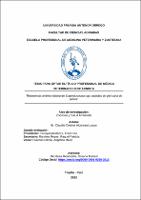| dc.contributor.advisor | Mendoza Mendocilla, Roxana Marisol | |
| dc.contributor.author | Alcantara Luque, Claudia Cristina | |
| dc.creator | Alcantara Luque, Claudia Cristina | |
| dc.date.accessioned | 2022-12-27T21:36:46Z | |
| dc.date.available | 2022-12-27T21:36:46Z | |
| dc.date.issued | 2022 | |
| dc.identifier.uri | https://hdl.handle.net/20.500.12759/9920 | |
| dc.description.abstract | El uso indiscriminado de antimicrobianos ha ocasionado una transmisión
bidireccional de cepas con genes de resistencia entre humanos y animales,
siendo un problema en la salud pública. Por lo que, el objetivo de la investigación
fue determinar la tasa de resistencia de las cepas de Staphylococcus spp.
aisladas de 100 caninos aparentemente sanos a siete antibióticos comúnmente
usados en la práctica diaria. Se utilizaron técnicas de cultivo microbiológicas y
pruebas bioquímicas, para identificar fenotípicamente las cepas evaluadas, y el
método de Kirby Bauer para determinar la resistencia antibiótica. La prueba de
Chi cuadrado se empleó para demostrar si existe asociación o no con las
variables cualitativas de edad, sexo, raza, problemas dermatológicos pasados y
terapia antibiótica previa con la resistencia antibiótica de las cepas encontradas.
Los resultados indican que, del total de muestras evaluadas, solo se aislaron
cepas de Staphylococcus coagulasa negativos (SCN), 75 de piel y 58 de oídos;
y además, se reporta que la penicilina y la eritromicina fueron los antimicrobianos
con mayor tasa de resistencia, 47% (35/75) y 39% (29/75) en piel,
respectivamente, y 50% (29/58) y 33% (19/58) en oídos, respectivamente.
También se encontró que 28 cepas de Staphylococcus coagulasa negativas
aisladas de piel son multidrogo resistente, en el caso de las cepas aisladas de
oídos fueron 13 cepas resistentes a 3 o más antibióticos. Se concluye que la tasa
de resistencia antibacteriana de las cepas de SCN aisladas de piel
aparentemente sana y oídos de perros, es mayor frente a la penicilina y a la
eritromicina; asimismo, existe una asociación significativa de la edad y
problemas dermatológicos pasados (p<0.05) con la resistencia a la eritromicina
de las cepas aisladas de oídos de los caninos en estudio | es_PE |
| dc.description.abstract | The indiscriminate use of antimicrobials has caused a bidirectional transmission
of strains with resistance genes between humans and animals, being a public
health problem. Therefore, the objective of the research was to determine the
resistance rate of Staphylococcus spp. strains isolated from 100 apparently
healthy canines to seven antibiotics commonly used in daily practice.
Microbiological culture techniques and biochemical tests were used to
phenotypically identify the evaluated strains, and the Kirby Bauer method to
determine antibiotic resistance. The Chi-square test was used to demonstrate
whether or not there is an association with the qualitative variables of age, sex,
race, past dermatological problems, and previous antibiotic therapy with the
antibiotic resistance of the strains found. The results indicate that, of the total
number of samples evaluated, only coagulase-negative Staphylococcus (CoNS)
strains were isolated, 75 from the skin and 58 from the ears; and furthermore, it
is reported that penicillin and erythromycin were the antimicrobials with the
highest rate of resistance, 47% (35/75) and 39% (29/75) in skin, respectively, and
50% (29/58) and 33 % (19/58) in ears, respectively. It was also found that 28
strains of coagulase-negative Staphylococcus isolated from the skin are
multidrug resistant; in the case of the strains isolated from the ears, 13 strains
were resistant to 3 or more antibiotics. It is concluded that the rate of antibacterial
resistance of CoNS strains from apparently healthy skin buds and dog ears is
higher against penicillin and erythromycin; Although, there is a significant
association of age and past dermatological problems (p<0.05) with the resistance
to erythromycin of the strains isolated from the ears of the canines under study | en_US |
| dc.description.uri | Tesis | es_PE |
| dc.format | application/pdf | es_PE |
| dc.language.iso | spa | es_PE |
| dc.publisher | Universidad Privada Antenor Orrego | es_PE |
| dc.relation.ispartofseries | T_MED.VETE_166 | |
| dc.rights | info:eu-repo/semantics/openAccess | es_PE |
| dc.rights.uri | https://creativecommons.org/licenses/by/4.0/ | es_PE |
| dc.source | Universidad Privada Antenor Orrego | es_PE |
| dc.source | Repositorio Institucional - UPAO | es_PE |
| dc.subject | Piel | es_PE |
| dc.subject | Perros | es_PE |
| dc.title | Resistencia antimicrobiana de Staphylococcus spp aislados de piel sana de perros | es_PE |
| dc.type | info:eu-repo/semantics/bachelorThesis | es_PE |
| thesis.degree.level | Título Profesional | es_PE |
| thesis.degree.grantor | Universidad Privada Antenor Orrego. Facultad de Ciencias Agrarias | es_PE |
| thesis.degree.name | Médico Veterinario Zootecnista | es_PE |
| thesis.degree.discipline | Medicina Veterinaria y Zootecnia | es_PE |
| dc.subject.ocde | https://purl.org/pe-repo/ocde/ford#4.03.00 | es_PE |
| renati.advisor.orcid | https://orcid.org/0000-0001-9398-3613 | es_PE |
| renati.author.dni | 71413847 | |
| renati.advisor.dni | 18133790 | |
| renati.type | https://purl.org/pe-repo/renati/type#tesis | es_PE |
| renati.level | https://purl.org/pe-repo/renati/level#tituloProfesional | es_PE |
| renati.discipline | 841056 | es_PE |
| renati.juror | Carvajal Mestanza, Francisco | |
| renati.juror | Ramírez Reyes, Raquel Patricia | |
| renati.juror | Huamán Dávila, Angélica María | |
| dc.publisher.country | PE | es_PE |


